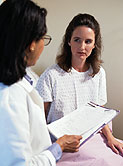
WEDNESDAY, May 2 (HealthDay News) — Bacteria that live normally in the vagina differ from woman to woman and can even change dramatically in short periods of time in the same woman, a new analysis reveals.
The findings are likely to alter the one-size-fits-all diagnosis and treatment of vaginal infections that currently prevails among obstetricians and gynecologists.
“This certainly changes the diagnosis, treatment and prevention of vaginosis (bacterial infection in the vagina),” said Stephen Dewhurst, chairman of microbiology and immunology at the University of Rochester Medical Center in New York. “Among other things, this makes vaginosis much harder to diagnose. If [vaginal bacteria] change over time, how sure are you that this really is vaginosis?”
Dewhurst was not involved with the study, which appears in the May 2 issue of the journal Science Translational Medicine.
“In the practice of medicine, all women have been considered pretty much the same when it comes to vaginal microbiota, with the same treatment,” said study senior author Jacques Ravel, an associate professor of microbiology and immunology at the University of Maryland School of Medicine in Baltimore. Antibiotics typically are prescribed to treat vaginosis.
“In some people [treatments] work really well, and in some they fail,” said Ravel, who also is associate director of the university’s Institute for Genome Sciences. “Now we know it’s because not all women are made equal.”
Prior research by the same group had identified five basic microbial communities in the vagina. The researchers also found that these communities tended to vary according to ethnicity.
The balance of microbial communities is vital in protecting women from infections, including sexually transmitted diseases.
But bacterial vaginosis — when one type of bacteria thrives and dominates other types, which raises the risk of infection — is extremely common.
Ravel and his co-authors collected vaginal bacterial samples from 32 healthy, reproductive-age women twice a week for four months, and then analyzed the samples using genomic techniques.
Again the researchers found five basic bacterial communities, and also noted that some changed rapidly in the same woman while others stayed stable.
In some cases, the collection of bacteria seen in a particular woman would have indicated the presence of bacterial vaginosis, although these women were healthy and not experiencing any symptoms.
“This changes what we consider to be a normal bacterial community in the vagina,” Dewhurst said.
Changes in bacterial communities tended to correspond with estrogen levels at different points in the menstrual cycle, the particular composition of bacteria in a woman’s vagina and sexual activity.
It’s also likely that what a woman eats or the environment in which she lives will affect microbial composition, Ravel added.
The authors postulated that microbiota that fluctuated regularly may make a woman more vulnerable to infection.
“Bacterial vaginosis is linked to transmission of HIV and other sexually transmitted diseases, so this is a potentially significant risk factor for acquiring sexually transmitted diseases,” Dewhurst said.
And if it turns out that there is a “new normal” of vaginal microbiota depending on the woman, this could curb the overuse of antibiotics, the authors said.
Vaginal bacteria also can affect pregnancy and fertility. The composition of vaginal microbiota and of a man’s sperm could mean that a woman is fertile with one man and infertile with another, an accompanying editorial suggested.
“We need to rethink the way we approach women’s health and treatment and diagnosis,” Ravel said.
More information
The U.S. Centers for Disease Control and Prevention has more on bacterial vaginosis.

